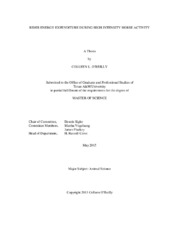| dc.description.abstract | Over the last century, horseback riding has evolved from a necessary mode of transportation to primarily a recreational activity. Despite the fact that horseback riding is a popular sport, there is little information available on horseback riding as a physical activity and the health benefits which could be obtained through horseback riding. Twenty subjects (age=22.4±3.4yrs, height=168.1±7.3cm, weight=67.5±15.5kg) were subjected to three riding tests, a 45min walk-trot-canter ride (WTC) , a reining pattern and a cutting pattern while wearing the Cosmed K4b^2 telemetric gas analyzer kit. Anthropometric data was obtained for each subject through DEXA scans including body fat, body mass index and lean body mass. Total energy expenditure, as well as mean and peak energy expenditure per minute, metabolic equivalents of task (MET), heart rate (HR), respiratory frequency (RF), pulmonary ventilation (VE), oxygen consumption (VO2) and relative oxygen consumption (relVO2) were all measured by the Cosmed K4b^2 system.
Because of time differences between tests, total energy expenditure of WTC was significantly higher (P≤0.05) than reining or cutting. However, the total energy expenditure observed in the WTC ride (194.7±3.84kcal) does provide insight into health benefits a 45 min ride could provide. Mean energy expenditure per minute as well as mean MET and HR data all indicated reining and cutting to be higher intensity (P≤0.05) than WTC. When WTC test was split by gait mean energy expenditure per min and MET increased as gait speed increased. Backward regression analyses were completed for total energy expenditure, energy expended per minute and MET for all subjects (n=20) and for women subjects only (n=17). The results of this study provide insight into horseback activity and discipline differences using a portable system as well as provide novel information about riders engaged in cutting and reining in comparison with a WTC ride. The data also indicate that it is possible, if riding at more intense gaits such as long trot and canter, for longer periods of time, for health benefits to be achieved through accumulated weekly horseback riding exercise. | en |


